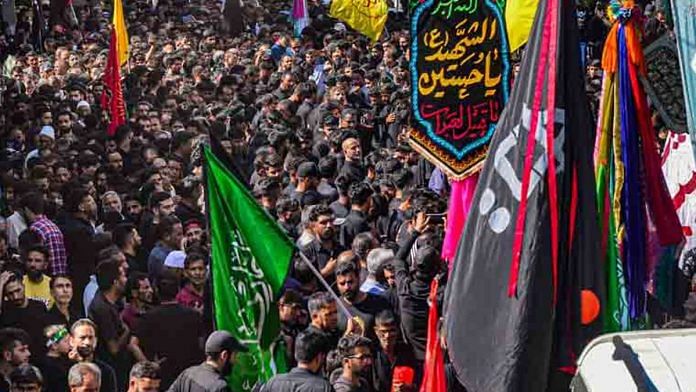New Delhi: After more than three decades, the Jammu & Kashmir (J&K) authorities decided to allow the 8th Muharram procession Thursday through the traditional route from Guru Bazar to Dalgate in Srinagar after several rounds of meetings, negotiations and deliberations over five weeks, sources in the security establishment told ThePrint.
The purpose behind allowing the procession, held between 6 am and 8 am, was to show to the world that “stability and peace have returned to the Kashmir Valley”, a source said.
“This was a calculated risk that we took,” the source added.
“A false narrative was spread every year that Kashmiris are not allowed to observe Muharram. Although a big procession was not allowed, people did observe Muharram every year. But what went in the international media was that people were being stopped.”
“We wanted to deflate this narrative and show the world that normalcy has returned to the Valley and a big procession can take place without any violence,” the source added.
Thursday was the first time after the abrogation of Article 370 on 5 August, 2019, that such a large gathering of about 30,000 people, mainly comprising mourners from the Shia sect of Islam, was allowed in J&K.
The two major processions on the 8th and 10th days of Muharram through the Guru Bazar to Dalgate route were banned in the late 1980s by the then J&K administration over alleged instigation of people and a “sensitive law and order situation”.
According to the source, it was realised after a detailed assessment of the security situation — which involved collecting details on the presence of foreign terrorists in the Valley and intelligence inputs on their movement — that the procession could be allowed on the route.
“If such a large event could be held without even a single stone being pelted or a single anti-national slogan, it speaks for itself that people here believe in peace, and that stability has returned to the Valley,” the source said.
“It is true that large-scale deployment of the police and other forces was done to make this happen, but it also shows that the separatists and the terrorists have lost control over the Valley and its people. Not even a single ISIS (Islamic State) flag, which used to be a common sight at processions, was seen at Thursday’s gathering.”
Another source told ThePrint that the government also wanted to “deflate the narrative that permission is given for the Amarnath Yatra every year and not for a Muharram procession”.
Also Read: Srinagar tense ahead of Muharram test as lockdown, pellets leave residents fuming
‘Permission with many conditions’
According to the second source, Shia leaders have approached the police and administration in J&K for permission to hold the Muharram procession every year, but they were denied due to security concerns.
There was always an apprehension that the procession would be “taken over” by “terrorist and secessionist elements”, the source said, adding that in the past, terrorists and separatists often “hijacked these processions and used them to peddle an anti-India narrative, instigating the people against the country”.
“They would showcase the state and the forces as oppressors, asking the people to rise against them. Jammu Kashmir Liberation Front leader Yasin Malik would often speak at these processions,” the source added.
But this time, after a security assessment and the laying down of several conditions, the go-ahead was granted, according to the source.
“We sat down with all the Shia leaders several times and were assured that there would be no room for any anti-national activity,” the source said.
The conditions included the following: No one would indulge in any “anti-national, anti-establishment speeches, sloganeering or propaganda and no activity should in any way affect the communal and sectarian harmony, and religious, ethnic, cultural and regional sentiments of the people”.
Moreover, it was instructed that no activity during the procession should be “prejudicial to the security and sovereignty of the state and should not disrespect any national symbol or emblem”.
A senior police officer told ThePrint: “We made it very clear that they should not hoist any flag depicting provocative slogans, text and or photos of terror outfits, or logos of banned organisations both national and international.”
“We told them that they should not cause any defacement or damage to the government or public property,” the officer said.
According to the police, several meetings over five weeks were carried out to ensure that the event passed off peacefully.
An official statement was also issued by the J&K administration saying that the decision to allow the procession was taken after assurances from the Shia community and representatives of all groups, as well as the local committee of Guru Bazaar, that the event would be conducted peacefully.
“Accordingly, all security arrangements would be put in place and people, especially members of the Shia community, are informed that no one would be allowed to take out any other procession individually or collectively on the route except the one to be taken out from Guru Bazaar which has the permission from the administration. Any one violating the orders will be very strictly dealt with as per the law,” the statement said.
(Edited by Nida Fatima Siddiqui)
Also Read: Kashmir photojournalist hit with pellets, 3 others hurt while covering Muharram procession



